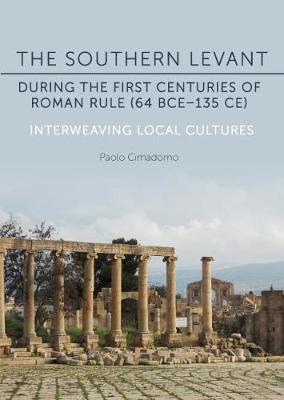Southern Levant during the first centuries of Roman rule (64

Southern Levant during the first centuries of Roman rule (64
The first focus lies on the area of Galilee and collecting all the evidence for reconstructing the history of the region. The theme of the ethnicity of the Galileans is very complex, as even the literary evidence of the first centuries BC and AD regarding Galilee doesn't specify anything about their ethnic identities. The question of the Arabs, their origins and ethnicity is also raised, with a particular focus on the Itureans and the Nabateans. Alongside a complete analysis of the territories they occupied, Cimadomo explores the different artefacts: from the sculptures to the pottery, from the temples to the coins, a picture emerges of an area influenced by different cultures where the inhabitants were able to create their own culture, different from all other parts of the Roman empire.
A chapter is devoted to the Decapolis, paying attention to the literary and architectural evidences of each city and their urban development in a little-studied period. An important feature that clearly emerges is the religious nature of the earlier settlements: most of them were probably sanctuaries during the Hellenistic time, and developed only after the coming of the Romans. It was during this development that theatres took a principal role, seemingly the first structures built in every city under Roman rule.
It becomes clear that the problems of homogenization and differentiation were present even in the past. Local inhabitants challenged their identity, adapting and modifying foreign impulses, creating new societies and new ways of being Roman.
PRP: 413.67 Lei
Acesta este Pretul Recomandat de Producator. Pretul de vanzare al produsului este afisat mai jos.
372.30Lei
372.30Lei
413.67 LeiIndisponibil
Descrierea produsului
The first focus lies on the area of Galilee and collecting all the evidence for reconstructing the history of the region. The theme of the ethnicity of the Galileans is very complex, as even the literary evidence of the first centuries BC and AD regarding Galilee doesn't specify anything about their ethnic identities. The question of the Arabs, their origins and ethnicity is also raised, with a particular focus on the Itureans and the Nabateans. Alongside a complete analysis of the territories they occupied, Cimadomo explores the different artefacts: from the sculptures to the pottery, from the temples to the coins, a picture emerges of an area influenced by different cultures where the inhabitants were able to create their own culture, different from all other parts of the Roman empire.
A chapter is devoted to the Decapolis, paying attention to the literary and architectural evidences of each city and their urban development in a little-studied period. An important feature that clearly emerges is the religious nature of the earlier settlements: most of them were probably sanctuaries during the Hellenistic time, and developed only after the coming of the Romans. It was during this development that theatres took a principal role, seemingly the first structures built in every city under Roman rule.
It becomes clear that the problems of homogenization and differentiation were present even in the past. Local inhabitants challenged their identity, adapting and modifying foreign impulses, creating new societies and new ways of being Roman.
Detaliile produsului








